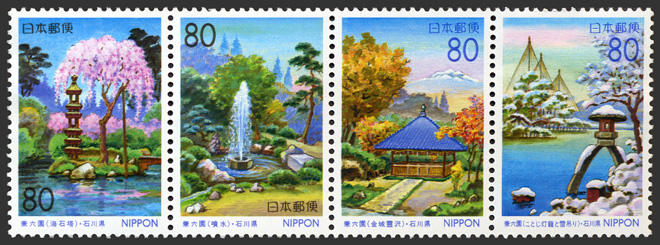Four Seasons of Kenrokuen Garden
 |
|||
| R288: Kaisekitou Pagoda |
R289: Fountain |
R290: Kinjou-reitaku spring |
R291: Kotoji stone lantern and yukitsuri |
| Issue | Four Seasons of Kenrokuen Garden | |||
| Prefecture | Ishikawa | |||
| Date of Issue | 26 April 1999 (Heisei 11) | |||
| Denomination | 80 yen x a se-tenant strip of four stamps | |||
| Designes | R288:Kaisekitou Pagoda in Spring | R289:Fountain in Summer | R290:Kinjou-reitaku spring in Autumn | R291:Kotoji stone lantern and yukitsuri in Winter |
| Quantity | 7,000,000 sets | |||
| Image Area | 22.5 x 33.0 millimeters | |||
| Printing | Photogravure in 5 colours | |||
| Sheet | 20 stamps (se-tenant strip of 4 stamps x 5) | |||
| Designer | Kawamura Kaku (Oil Painter) | |||
| Sold at | Post offices in Hokuriku, and the appointed post offices (see menu page) | |||
| First Day of Issue Postmark | Kanazawa Central Post Office | |||
Four Seasons of Kenrokuen Garden, Souvenir Sheet
| Issue | Four Seasons of Kenrokuen Garden, Souvenir Sheet Picture of the Sheet |
| Price | 320 yen (80 yen x a se-tenant strip of four stamps) |
| Sheet Size | 137.5 x 93.5 millimeters |
| Sheet | a se-tenant strip of four stamps |
| Catalog No. | R291A |
Japanese Stamp Specialized Catalog (JSCA) & SAKURA Catalog numbers are adopted.